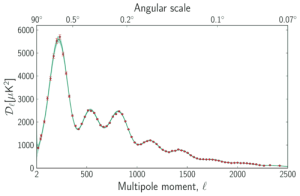Some colleagues have suggested that my posting on Planck Day was overly frivolous, given the huge importance of what Planck has achieved. (Nicely written up by Andrew Jaffe.) Other colleagues have suggested that Planck Day was bad press, as it was such a huge public non-event, with a big fuss about mild parameter adjustment. I find both these things true, leaving a weird sense of tension and excitement. I’d better explain myself.
First, lets be clear about the technical achievement. Planck is an absolute triumph of technology, engineering, management, and organisation. An amazing machine that has worked beautifully. It also represents a stunning scientific achievement. The lamda-CDM model, and its beautifully articulated engine of prediction, is a conceptual and analytic triumph. Of course this triumph belongs not just to the Planck team, but represents the accumulated achievement of many scientists all over the world over a number of years.
Lets just look at that power spectrum fit. It is not just a question of the theoretical curve going vaguely up and down, in more or less the same way as the data. The detailed agreement is gob-smacking – multiple peaks, their positions, their sizes, their widths, their second and third order curvature. Any scientist will look at this and think “no way is this a fluke”. Don’t let doubters trot out that coffee-time stuff about being able to fit anything with enough parameters. Firstly, that old chestnut is largely nonsense, and secondly, the fit quality is way beyond that.

And yet – outside the world of the CMB, the CDM paradigm has problems, as we were reminded here at ROE the day after Planck Day, in a nice wee coffee talk by Jorge Penarrubia.The best known problems are that CDM predicts far too many dwarf galaxies, and galaxy profiles that are much cuspier than observed, but there are other claims, such as the existence of a very unlikely polar structure of dwarfs surrounding the Milky Way, and of suspicious uniformities in galaxy rotation curves. All these problems may still get patched up by astrophysical fixes to do with feedback, IMF games, etc… but we don’t know yet.
Its common to hear people say that Particle Physics and Cosmology are in a similar situation – a model rather than a theory – a perfect fit but with no explanation. Why do all those parameters have those particular values? It seems so arbitrary. And what are dark matter and dark energy anyway? In this view, even the boringly successful fit is tantalising because it tells us there must be a deeper theory in waiting that will explain the perfect fit.
That may describe particle physics, but it doesn’t describe cosmology. Rather, what we have is perfect but fishy. How can the model be so perfect in some places and so poor in others? Have we missed something simple? It may well be that the astrophysical fixes do the trick, and then cosmology does look indeed like particle physics – successful but unsatisfying. Or it could be that some conceptual change is needed, and a revolution is waiting.
I’d give the revolution 2:1 against. But thats good enough odds that your eyes are glued to the table… Mesdames et Messieurs, faites vos jeux.
